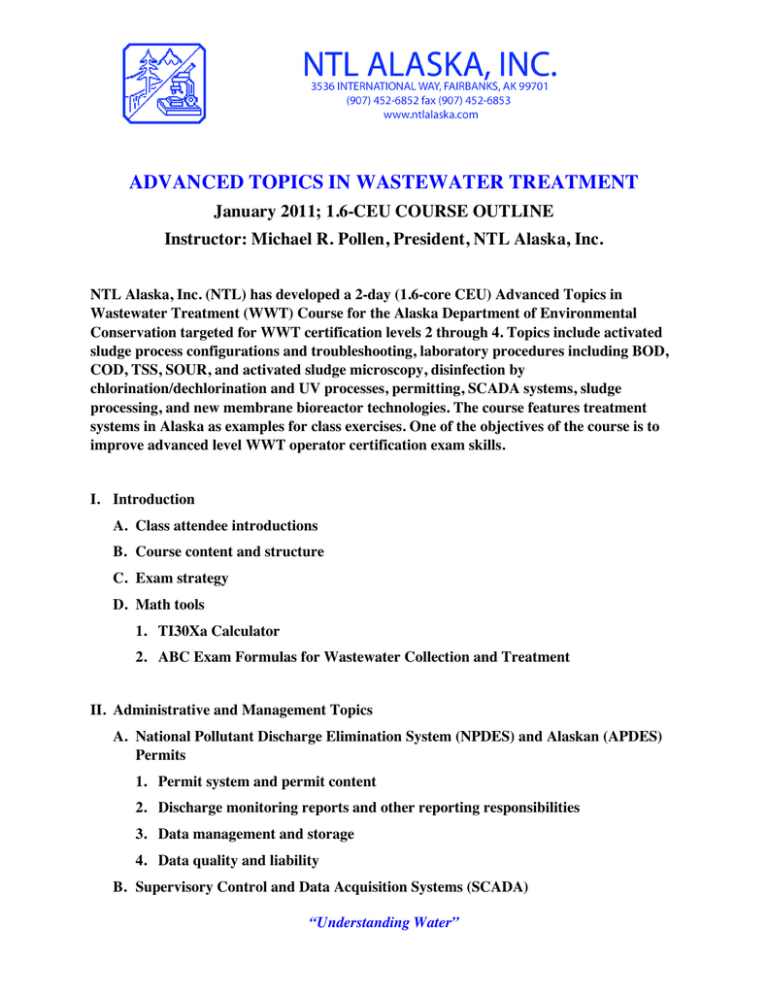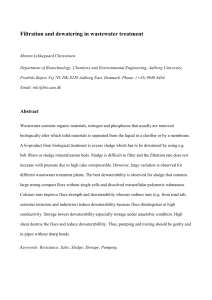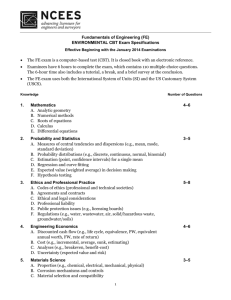advanced topics in wastewater treatment
advertisement

ADVANCED TOPICS IN WASTEWATER TREATMENT January 2011; 1.6-CEU COURSE OUTLINE Instructor: Michael R. Pollen, President, NTL Alaska, Inc. NTL Alaska, Inc. (NTL) has developed a 2-day (1.6-core CEU) Advanced Topics in Wastewater Treatment (WWT) Course for the Alaska Department of Environmental Conservation targeted for WWT certification levels 2 through 4. Topics include activated sludge process configurations and troubleshooting, laboratory procedures including BOD, COD, TSS, SOUR, and activated sludge microscopy, disinfection by chlorination/dechlorination and UV processes, permitting, SCADA systems, sludge processing, and new membrane bioreactor technologies. The course features treatment systems in Alaska as examples for class exercises. One of the objectives of the course is to improve advanced level WWT operator certification exam skills. I. Introduction A. Class attendee introductions B. Course content and structure C. Exam strategy D. Math tools 1. TI30Xa Calculator 2. ABC Exam Formulas for Wastewater Collection and Treatment II. Administrative and Management Topics A. National Pollutant Discharge Elimination System (NPDES) and Alaskan (APDES) Permits 1. Permit system and permit content 2. Discharge monitoring reports and other reporting responsibilities 3. Data management and storage 4. Data quality and liability B. Supervisory Control and Data Acquisition Systems (SCADA) “Understanding Water” ADVANCED TOPICS IN WASTEWATER TREATMENT 1.6-CEU COURSE OUTLINE Page 2 of 2 1. O&M of WWTPs using SCADA a. Automated data acquisition sensors and transmitters b. Data compilation, trend monitoring, and alarms c. Report generation and data storage systems III. Activated Sludge Process Configurations A. Basic Activated Sludge Process Theory B. Activated Sludge Configurations 1. Conventional including tapered aeration, step feed, and other loading/aeration adaptations 2. High rate including contact stabilization 3. Extended aeration including package plants 4. Fixed film + suspended growth hybrid systems (RBC, FAST, MBBR) C. Biological Nutrient Removal (BNR) 1. Nitrification & denitrification 2. Anaerobic phosphorus removal IV. Membrane Bioreactors (MBR) A. General Design and Process Theory 1. External separation systems 2. Submerged (internal) systems 3. BNR adaptations V. Laboratory Topics & Activated Sludge Process Control A. Oxygen Demand Tests 1. Biochemical Oxygen Demand (BOD) including carbonaceous (CBOD) and soluble (dissolved) BOD fractions 2. Chemical Oxygen Demand (COD) 3. Specific Oxygen Uptake Rate (SOUR) B. Solids Tests “Understanding Water” ADVANCED TOPICS IN WASTEWATER TREATMENT 1.6-CEU COURSE OUTLINE Page 3 of 3 1. Settleometer tests 2. Total and Volatile Suspended Solids (TSS & TVSS) 3. Mixed Liquor Suspended and Volatile Solids (MLSS and MLVSS) C. Process control calculations 1. Food/Microorganism Ratio (F/M) 2. Sludge Age 3. Mean Cell Residence Time (MCRT) 4. Sludge inventory control – waste activated sludge rates D. Microbiology 1. Fecal Coliform Bacteria 2. Activated sludge microbiology including filament identification and troubleshooting E. UV Absorbance and Transmittance (UVA & UVT) VI. Disinfection A. Chlorination and dechlorination 1. Chlorination theory including breakpoint chlorination 2. Dechlorination chemistry 3. Chlorination and dechlorination equipment 4. Onsite generation of sodium hypochlorite B. Ultraviolet (UV) disinfection systems 1. UV disinfection theory 2. UV system O&M VII. Sludge Processing A. Sources and Characteristics of Sludge 1. Grit and screenings 2. Primary sludge 3. Scum 4. Secondary sludge “Understanding Water” ADVANCED TOPICS IN WASTEWATER TREATMENT 1.6-CEU COURSE OUTLINE Page 4 of 4 B. Volume Reduction and Stabilization 1. Aerobic digestion including autothermal aerobic digestion 2. Anaerobic digestion 3. Composting C. Thickening Technologies 1. Gravity thickeners 2. Gravity belt thickeners D. Dewatering Technologies 1. Centrifuges & decanters 2. Horizontal belt filters 3. Pressure filters 4. Sand beds E. Sludge (“Biosolids”) Disposal Techniques 1. Incineration 2. Landfill disposal 3. Land application “Understanding Water”




